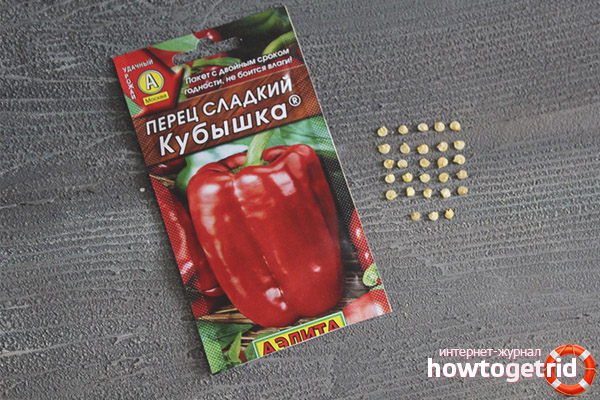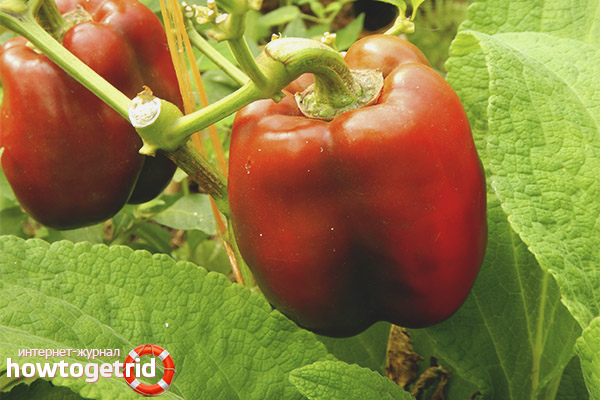The content of the article
Fruits can be used fresh, they are rich in vitamins and minerals. From Kubyshka pepper, an excellent lecho, ketchup, is obtained. The taste of the fruit is quite high. The growing season of the plant ranges from 140 to 155 days. The fruits are very tasty, with a dense, elastic skin, their characteristic feature is a large amount of carotene. There are not many seeds in the chambers of the Kubyshka pepper.
Grade description
This culture belongs to mid-season varieties. On the lower branches, the fruits can reach a weight of 500 g. The pulp of pepper contains a significant part of substances valuable to the human body: from 2 to 5% sugars, 1.3 - 2.2% organic acids, 0.3% pectin substances, a complex of vitamins and trace elements.
The advantages of the culture include resistance to a large number of diseases of nightshade and apical rot. With proper care and favorable weather conditions, the crop can be harvested until late autumn. The variety has an advantage: the fruits are not affected by gray rot, do not crack.
Growing pepper seedlings
In order to get the maximum yield, it is enough to follow certain recommendations exactly.
Growing bell pepper Kyshlok is possible only in the seedling method. To get healthy, strong seedlings, you need to take care of buying seeds and preparing the soil in advance. Purchase seeds from trusted suppliers in specialized stores. Before sowing the seeds must be checked for germination. Bell pepper seeds are stored for up to three years.
It is important to decontaminate the soil from diseases before transplantation. To stimulate germination, use biostimulants, such as heteroauxin. Soak the grains for a day in warm water, immediately before planting, process in a pink solution of potassium permanganate.
Seeding is carried out to a depth of 1.5-2 cm, do not immerse the seeds too deep in the soil, this inhibits germination.
After sowing, cover the container or box with seeds with plastic wrap or glass. In the first three to four days, light is not needed, enough heat and humidity. At a temperature of 22-24 degrees, the seeds will germinate in 6-7 days. After emergence, it is necessary to provide access to sunlight.
Seeds of bell pepper for seedlings are sown in early March. During this period of the year, daylight hours are short; plants need additional illumination with special lamps for two hours in the morning and evening.
If there is not enough light for the young plants, the seedlings will begin to suffer, it will stretch, turn yellow. Such plants will not yield crops, will be sick for a long time after transplantation. If you cannot provide enough light for seedlings, then postpone sowing the seed until early April.
After sowing, spraying the surface of the soil should be done every day. The best time to plant pepper for seedlings is mid-March.
Pepper is a thermophilic culture. He does not tolerate drafts, lowering the temperature to 14-13 degrees. At a temperature of 12 degrees, the seedlings stop growing, the leaves fade, the root system stops growing, freezes. Such plants will never bring a plentiful harvest, they will not take root well after transplanting, they will constantly hurt. Even fertilizing with fertilizers and regular watering with warm water will not help them.
At the age of 2-3 weeks, the first fertilizing with nitrogen fertilizers is carried out. Urea solution or ammonium nitrate can be used. Before fertilizing the plants are watered. Do not let the solution get on young foliage.
After the seedlings have grown stronger, the first leaves will grow from them. It will be possible to remove the plastic film and pick it in separate pots.
Pepper seedlings from bright sunlight can get burns, it is recommended to cover it from light with screens made of paper or cardboard.
At the age of 25-30 days, plants dive in separate pots or glasses. Picking is an important procedure that stimulates the growth of the root system. If you leave the plants and continue to grow in one container, they will begin to interfere with each other, they will compete for sunlight, nutrients. Stronger instances will begin to oppress the weak neighbors. Plants will start to stretch, from such seedlings never get full bushes of bell pepper.
To keep daytime warm at night, some gardeners put buckets of water in the greenhouses.
Planting seedlings in the ground or greenhouse
Bulgarian peppers do not tolerate transplantation. Try to transplant seedlings from pots into the ground or a greenhouse with a lump of earth. The roots are restored within 10-12 days. Depending on the weather, seedlings are planted in open ground from May 20 to June 5.
Poor, diseased seedlings are doomed to poor survival and the loss of a significant part of the crop.
Do not rush to plant seedlings. The threat of return frosts in May should completely pass; the temperature of the soil should warm up to 12-13 degrees. Bell pepper loves warmth and light. Moreover, the larger the fruits, the more heat-loving the plant.
If the planted seedlings undergo a drop in temperature to 13 degrees, it will slow down its growth, and even it may die. Seedlings are not recommended to be planted on sandstones and in windy areas.
Water the plants with warm water in the planting holes or under the root. Peppers may have sunburn from droplets of water on the leaves. On one meter, plant no more than 2 bushes. With thickened plantings, plants develop worse, strong bushes inhibit neighboring plants, and productivity decreases. Do not forget that the root system of Bulgarian pepper develops strongly, nearby plants will interfere with each other, compete for fertilizers, a place in the sun.
When planting in the holes, you can add humus or rotted compost, a little wood ash. In no case should you place the bushes close to each other.
Immediately after planting, plants are abundantly watered. When planting, warm water is added to the holes, so that the roots stick to the lumps of soil and the plant is better, faster take root.
Experienced gardeners recommend mulching the soil under the bushes or in the aisles. This technique allows you to save moisture in the surface layer of the soil. When mulching, the soil retains its porous structure, earthworms and beneficial insects actively develop in it, the soil is saturated with oxygen.
Bell pepper, which is grown using mulching and regular loosening of the soil, always turns out to be large and sweet.
Care
Pepper is responsive to fertilizing with organic fertilizers. A very good result was shown by dressing bell pepper with herbal infusion. For its preparation, nettle, garden weeds, mowed lawn grass are used.
Herbal material is folded into a metal or plastic barrel, poured with warm water, left to ferment for 2-3 weeks. Fermented slurry is filtered, diluted with water, the resulting solution is watered pepper bushes at the root. The beds where peppers are grown should be seasoned with humus. Such bushes bear fruit well, give a plentiful harvest before the onset of frost.
When growing Pepper pepper, it is very important to form a correct bush. Stepsons must be removed in a timely manner, not to allow lateral shoots to develop excessively. It is necessary to timely remove the lower leaves, if necessary, tie the plants to the supports.
To get a large number of fruits, pick peppers in a state of technical ripeness. Removing the fruit stimulates the appearance of a new ovary. Blooming pepper Kyshlka occurs in waves, with intermediate periods of dormancy. This variety gives high yields, both in open and in closed ground.
It is worth noting that the Kubyshka variety feels more comfortable in greenhouse conditions. The key to a high yield is strong, healthy seedlings. The soil near the plants should not be too waterlogged, this can lead to damage to the root system by rot.
Much attention is paid to pinching peppers in greenhouse conditions in order to plant them denser and get large fruits.
Sweet pepper is a self-pollinating crop, and bitter varieties are cross-pollinating species. If you grow them nearby, then the plants can become pollinated, as a result, you will get fruits with bitterness.
Starting to work on the earth, one should remember the well-known rule of the farmer: everything taken from the earth must be returned to her. Experienced gardeners are advised to lay compost heaps in mid-summer.
Rural residents love this variety of bell pepper for their unpretentiousness and high productivity. Experienced gardeners select planting material from bushes with good qualities.
Video: Pepper Egg












Submit